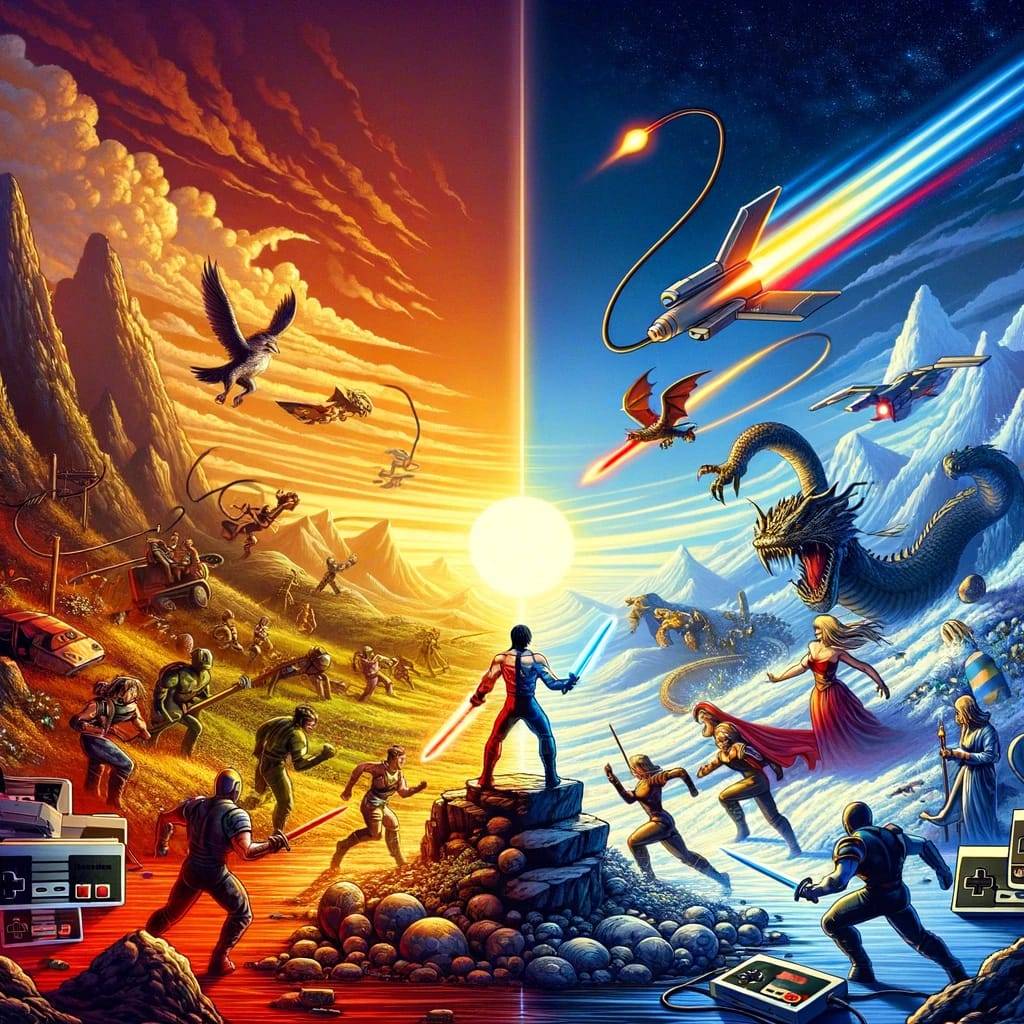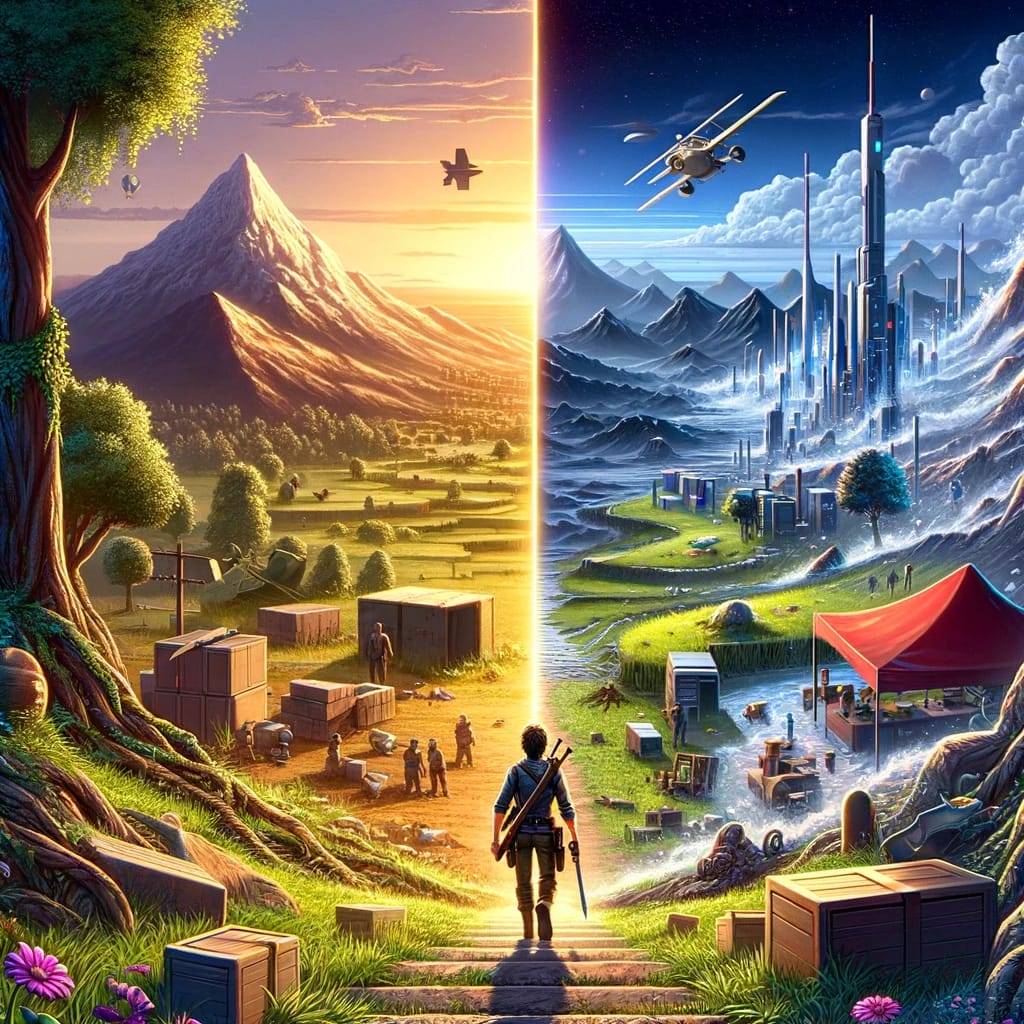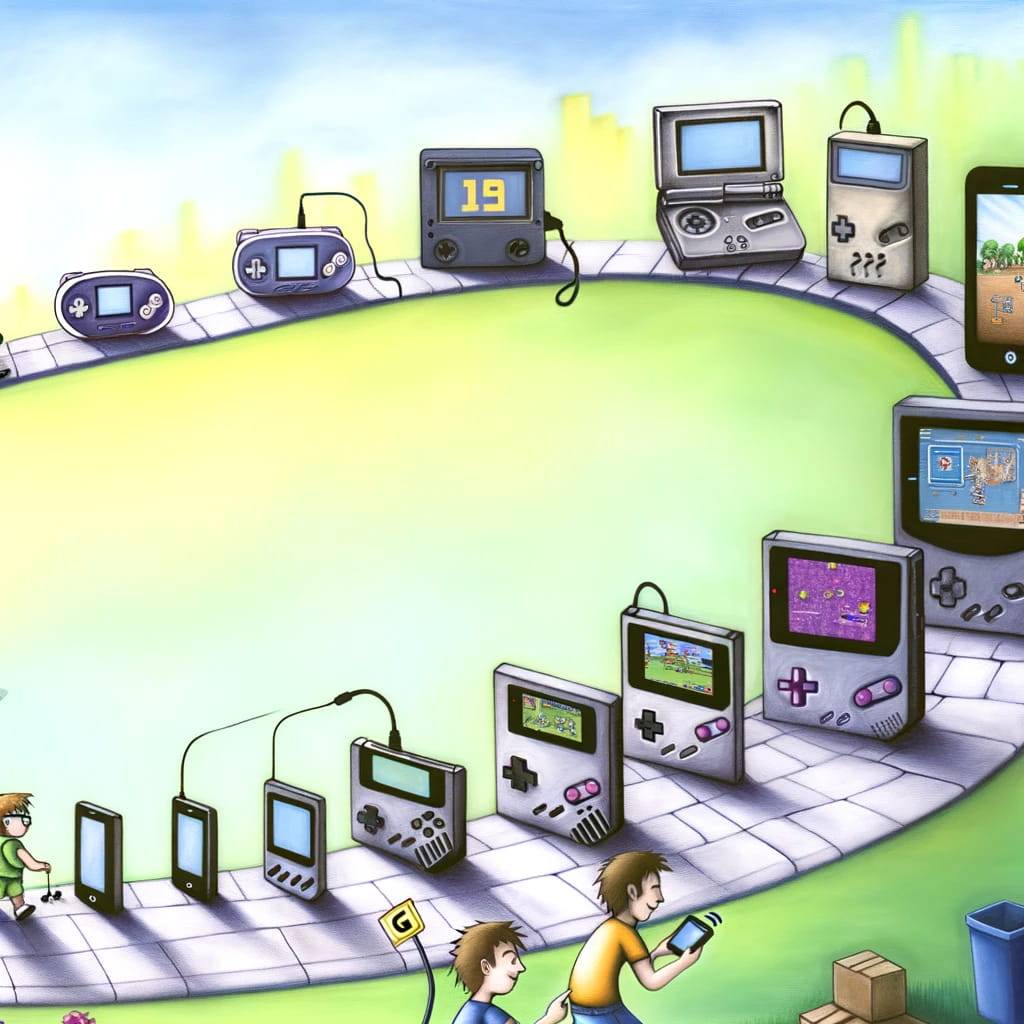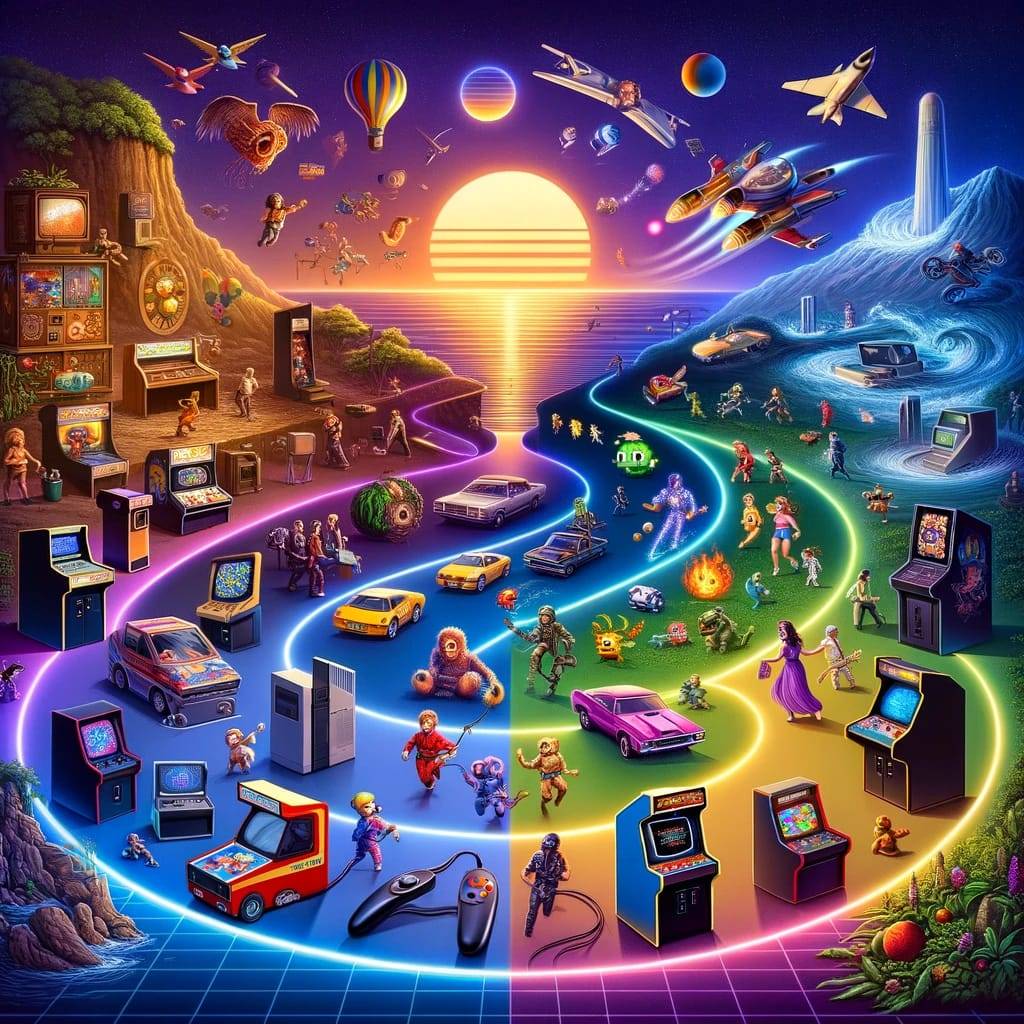Ah, retro gaming—a pixelated portal to the past, where the bleeps and bloops of a bygone era invite us on a nostalgic quest. Remember the thrill of blowing into a cartridge, the satisfaction of hitting a high score on an arcade cabinet, or the simple joy of guiding a plucky plumber through mushroom-filled lands? Retro gaming isn’t just about revisiting these memories; it’s a celebration of the milestones that laid the foundation for today’s virtual worlds.
So, grab your joystick (or controller), and let’s rewind through the annals of gaming history to uncover the milestones that made us and the industry what we are today. Are you ready to jump back in time?
The Dawn of Video Gaming: The 1970s
The journey into the pixelated past begins in the late 1960s and early 1970s, with the birth of video gaming as we know it. It was a time of innovation and experimentation, leading to the creation of games that would set the stage for all future endeavors in the digital gaming universe.
Pong: The Beginning
The Simple Start: Imagine a world before the internet, smartphones, and even personal computers were commonplace. Here, in 1972, Atari introduced Pong, a simple tennis simulation game. It wasn’t just a game; it was the spark that ignited the gaming industry, proving that video games could be a viable commercial entertainment form.
The Home Console Revolution
Bringing Games Home: Fast forward a few years, and the Magnavox Odyssey, the first home video game console, makes its debut. While primitive by today’s standards, with basic graphics and no sound, it was revolutionary, making the dream of playing video games at home a reality.
The Arcade Craze
Coins and Cabinets: The late ’70s and early ’80s witnessed the golden age of arcade games. Titles like Space Invaders, Asteroids, and Pac-Man weren’t just games; they were cultural phenomena that transcended the arcade, influencing music, movies, and more. These cabinets did more than consume quarters; they brought people together, creating a communal gaming experience that’s still fondly remembered.
This era laid the groundwork for everything that followed, transforming video gaming from a niche hobby into a cornerstone of pop culture. The innovation and creativity of these early years still resonate, reminding us that sometimes, simplicity breeds the most enduring forms of entertainment.
Next, we’ll jump into the 8-bit revolution, where gaming started to take on the forms and characters that are beloved by many today.
The 8-Bit Revolution: The Early to Mid 1980s

As we delve deeper into the pixelated past, the early 1980s mark a pivotal era in gaming history: the rise of the 8-bit generation. This period introduced gamers to a new level of complexity and storytelling, thanks to advances in technology and creativity.
The Nintendo Entertainment System (NES) Takes the World by Storm
- A Gaming Renaissance: After the video game crash of 1983, the industry was in dire straits. Enter the NES in 1985, with its robust hardware and iconic titles like Super Mario Bros. and The Legend of Zelda. It wasn’t just a console; it was a lifeline that revived the industry and brought video games into the mainstream.
Characters and Worlds to Remember
- Birth of Icons: This era introduced characters who would become the face of video gaming. Mario, Link, and Mega Man started here, in 8-bit form, embarking on adventures that players had never seen before. These characters transcended their pixelated origins to become cultural icons.
Gameplay Evolution
- Beyond Paddles and Joysticks: The games of the 8-bit era were more than simple diversions; they were complex, challenging, and rich with story. They demanded skill, strategy, and patience, offering rewards in the form of sprawling worlds and narratives that captivated the imagination.
The 8-bit revolution set the standard for what video games could be, proving they were capable of delivering experiences as rich and engaging as any movie or book. It was a time of rapid innovation that laid the groundwork for the gaming industry’s future, shaping the tastes and expectations of a generation of gamers.
Next, we’ll explore the 16-bit era and the console wars that defined it, showcasing how competition drove the industry to new heights.
16-Bit and the Console Wars: The Late 1980s to Early 1990s

The mid to late 1980s and early 1990s heralded the arrival of the 16-bit era, a period marked by significant technological advancements, richer game narratives, and one of the most heated rivalries in video game history.
Technological Leap
- A New Dimension in Gaming: The transition from 8-bit to 16-bit technology allowed for greater graphical fidelity, more complex game mechanics, and enhanced audio capabilities. This leap forward made games more immersive and visually captivating than ever before.
Sega vs. Nintendo: The Console Wars
- Rival Titans: At the heart of the 16-bit era was the fierce competition between Sega’s Genesis (Mega Drive outside North America) and Nintendo’s Super Nintendo Entertainment System (SNES). This rivalry wasn’t just about sales; it was a battle for the soul of gaming, with each company pushing the other to innovate and improve.
Memorable Games and Franchises
- The Golden Age of Gaming: This era gave us classics like “Sonic the Hedgehog,” “Super Mario World,” “The Legend of Zelda: A Link to the Past,” and “Street Fighter II.” These titles didn’t just define the 16-bit generation; they left a lasting legacy that continues to influence the gaming industry.
Impact on Pop Culture
- Beyond the Console: The console wars extended beyond the hardware, influencing marketing strategies, pop culture, and even the development of new game genres. It was a time when video game commercials were as eagerly anticipated as the games themselves, and characters like Sonic and Mario became household names.
The 16-bit era and the console wars represented a pivotal moment in gaming history, one where competition fueled innovation, resulting in a golden age of gaming that expanded the medium’s possibilities and reach.
As we move forward, we’ll delve into the rise of 3D gaming, exploring how this technological advancement changed the gaming landscape forever.
The Rise of 3D Gaming: The Mid to Late 1990s

As the gaming industry marched into the mid-1990s, a new technological frontier was on the horizon—the transition from 2D to 3D gaming. This period marked a significant evolution in how games were developed, played, and experienced, opening up new worlds of possibilities.
Breaking the 2D Barrier
- A New Perspective: The introduction of 3D graphics in video games was a game-changer, quite literally. Titles like Doom and Wolfenstein 3D offered players a first-person perspective, immersing them in the game world in ways previously unimaginable.
Console Innovations
- Pioneering Platforms: The Sony PlayStation and the Nintendo 64 were at the forefront of bringing 3D gaming into the living room. The PlayStation’s CD-ROM technology and the N64’s cartridge system provided the storage and speed needed for complex 3D environments, revolutionizing console gaming.
Iconic 3D Titles
- Game Changers: Games like Super Mario 64 and The Legend of Zelda: Ocarina of Time on the N64, and Final Fantasy VII and Metal Gear Solid on the PlayStation, not only demonstrated the potential of 3D gaming but also set new standards for game design, storytelling, and immersion.
Impact on Game Development
- New Design Challenges and Opportunities: The shift to 3D introduced new complexities in game design and development. It required more sophisticated programming, art, and storytelling techniques, pushing developers to innovate and experiment.
The rise of 3D gaming was more than just a technological advancement; it was a cultural shift that expanded the gaming audience and influenced countless genres. From immersive RPGs and action-packed shooters to exploratory adventure games, 3D gaming paved the way for the diverse gaming ecosystem we enjoy today.
Next, we’ll explore the emergence and impact of portable gaming, highlighting how it brought the gaming experience out of the living room and into the palms of our hands.
Portable Gaming Takes Off: From the Late 1980s Onwards

The evolution of gaming took another significant turn with the advent of portable gaming systems. This era marked a departure from the need to be tethered to a console connected to a television, offering gamers the freedom to play wherever they went.
The Game Boy Revolution
- Bringing Gaming on the Go: Nintendo’s Game Boy, launched in 1989, wasn’t the first portable gaming device, but it was the one that truly popularized the concept of handheld gaming. With its compact design, long battery life, and a robust library of games, including the iconic “Tetris,” the Game Boy set the standard for what portable gaming could be.
Technological Advancements
- More Power, Better Graphics: As technology advanced, so did handheld gaming systems. Devices like the Game Boy Advance, the Nintendo DS, and the PlayStation Portable (PSP) offered increasingly sophisticated gaming experiences, with better graphics, more complex games, and features like touch screens and internet connectivity.
The Rise of Mobile Gaming
- Gaming in Everyone’s Pocket: The advent of smartphones and app stores transformed mobile phones into powerful gaming platforms. Titles like “Angry Birds” and “Candy Crush Saga” became cultural phenomena, making gamers out of people who had never owned a traditional gaming console.
The Legacy and Future of Portable Gaming
- Hybrid Systems and Beyond: The lines between portable and console gaming have continued to blur, with systems like the Nintendo Switch offering the best of both worlds. Meanwhile, cloud gaming services promise a future where high-quality gaming experiences can be streamed to any device, making the concept of gaming on the go more accessible than ever.
Portable gaming has not only expanded the reach of video gaming into new spaces and times but also broadened its audience. It has made gaming a more integral part of our daily lives, offering entertainment, engagement, and social interaction wherever we are.
Next, we’ll delve into how retro games have influenced the modern gaming landscape, celebrating the timeless appeal of pixelated graphics, chiptune music, and gameplay that harkens back to the golden age of gaming.
The Legacy of Retro Games Today
In recent years, there’s been a significant resurgence in the popularity of retro games, a testament to their enduring appeal and the fond nostalgia they evoke. This revival isn’t just about replaying old classics; it’s influencing the modern gaming landscape in profound ways.
Indie Developers Embrace Retro
- Pixel Art and Chiptunes: Many indie game developers have adopted retro aesthetics and gameplay mechanics as a homage to the classics while infusing them with modern design principles. Games like “Shovel Knight” and “Stardew Valley” exemplify this trend, offering new experiences that feel both fresh and familiar.
The Mini Console Craze
- Classic Consoles Reimagined: Companies like Nintendo, Sony, and Sega have tapped into nostalgia by releasing miniature versions of their classic consoles preloaded with retro games. The NES Classic Edition, PlayStation Classic, and Sega Genesis Mini have introduced a new generation to the joys of retro gaming while providing older gamers a trip down memory lane.
Retro Gaming Communities and Events
- A Shared Passion: Online communities, retro gaming conventions, and eSports competitions focused on classic games have flourished, bringing together fans from around the world. These gatherings celebrate the history of gaming, offering spaces to share memories, trade games, and compete in old-school gaming tournaments.
Preservation and Accessibility
- Keeping History Alive: The interest in retro games has also highlighted the importance of preservation, with organizations and enthusiasts working to ensure these digital artifacts are not lost to time. Meanwhile, modern platforms and services are making retro games more accessible than ever, from digital re-releases to subscription-based game libraries.
The legacy of retro games in today’s gaming world is a reminder of the medium’s rich history and the timeless quality of well-crafted game design. They prove that great games never truly go out of style, continuing to inspire, entertain, and bring people together, just as they did decades ago.
In conclusion, as we reflect on the milestones of retro gaming, it’s clear that these games have shaped not only the industry but also the lives of countless gamers. Their legacy lives on, not just in the pixels of yesteryear but in the spirit of innovation and community that defines gaming culture today.
What are your favorite retro gaming memories? Which classic games do you find yourself returning to, and why? Share your stories in the comments below and let’s celebrate the games that started it all.
Conclusion: Celebrating the Pixels of Yesteryear
As we wrap up our nostalgic journey through the milestones of retro gaming, it’s evident that these pixelated adventures, blocky heroes, and chiptune soundtracks have left an indelible mark on the fabric of gaming culture. Retro games did more than entertain; they sparked imagination, fostered community, and paved the way for the technological marvels we enjoy today.
The Timeless Appeal of Retro Gaming
Retro gaming’s resurgence isn’t merely a fad; it’s a celebration of gaming’s roots and a testament to the enduring power of good game design. These games remind us that within their simplistic graphics and straightforward mechanics lie the heart and soul of what makes gaming so captivating.
Lessons for the Future
Today’s game developers can look back at retro games for inspiration, drawing on their ingenuity, creativity, and the emotional connections they forged with players. The principles that made these games great—engaging gameplay, compelling storytelling, and imaginative worlds—are as relevant now as they were decades ago.
A Shared Legacy
Whether you grew up feeding quarters into an arcade machine, swapping NES cartridges with friends, or you’re discovering these classics for the first time on a modern console, retro games are a shared heritage that continues to unite gamers across generations.
Now, we turn the joystick over to you. What retro games have captured your heart? Do you have a cherished memory of battling pixelated foes, solving puzzles, or exploring 8-bit landscapes? Share your retro gaming stories in the comments below. Let’s continue to celebrate the games that laid the foundation for our favorite pastime and ensure their legacies live on for future generations to enjoy.







